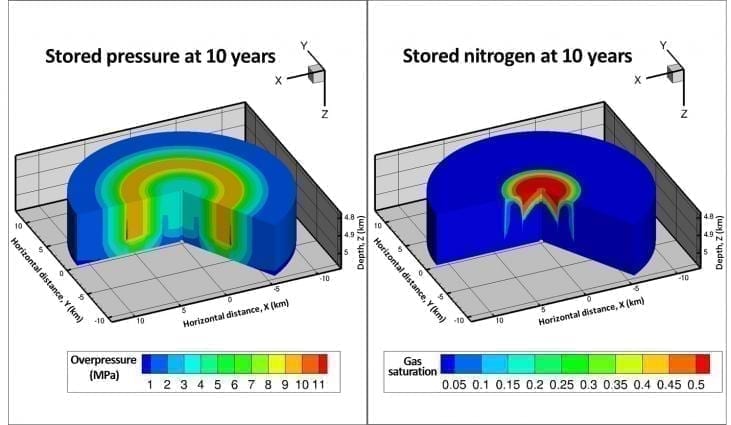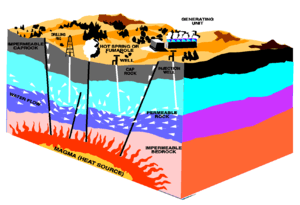
New power plant design to expand use of geothermal energy in the U.S.
Researchers are developing a new kind of geothermal power plant that will lock away unwanted carbon dioxide (CO2) underground – and use it as a tool to boost electric power generation by at least 10 times compared to existing geothermal energy approaches.
The technology to implement this design already exists in different industries, so the researchers are optimistic that their new approach could expand the use of geothermal energy in the U.S. far beyond the handful of states that can take advantage of it now.
At the American Geophysical Union meeting on Friday, Dec. 13, the research team debuted an expanded version of the design, along with a computer animated movie that merges advances in science with design and cognitive learning techniques to explain the role that energy technologies can have in addressing climate change.
The new power plant design resembles a cross between a typical geothermal power plant and the Large Hadron Collider: It features a series of concentric rings of horizontal wells deep underground. Inside those rings, CO2, nitrogen and water circulate separately to draw heat from below ground up to the surface, where the heat can be used to turn turbines and generate electricity.
The design contrasts with conventional geothermal plants, explained study co-author Jeffrey Bielicki, assistant professor of energy policy in the Department of Civil, Environmental and Geodetic Engineering and the John Glenn School of Public Affairs at The Ohio State University.
“Typical geothermal power plants tap into hot water that is deep under ground, pull the heat off the hot water, use that heat to generate electricity, and then return the cooler water back to the deep subsurface. Here the water is partly replaced with CO2 or another fluid – or a combination of fluids,” he said.
CO2 extracts heat more efficiently than water, he added.
This approach – using concentric rings that circulate multiple fluids – builds upon the idea to use CO2 originally developed by Martin Saar and others at the University of Minnesota, and can be at least twice as efficient as conventional geothermal approaches, according to computer simulations.
“When we began to develop the idea to use CO2 to produce geothermal energy, we wanted to find a way to make CO2 storage cost-effective while expanding the use of geothermal energy,” said Jimmy Randolph, postdoctoral researcher in the Department of Earth Sciences at the University of Minnesota.
“We hope that we can expand the reach of geothermal energy in the United States to include most states west of the Mississippi River,” Bielicki said.
The current research team includes Ohio State, the University of Minnesota and Lawrence Livermore National Laboratory, where geoscientist Tom Buscheck came up with the idea to add nitrogen to the mix.
He and his colleagues believe that the resulting multifluid design will enable geothermal power plants to store energy away – perhaps hundreds of gigawatt hours – for days or even months, so that it is available when the electricity grid needs it. The underground geothermal formation could store hot, pressurized CO2 and nitrogen, and release the heat to the surface power plant when electricity demand is greatest. The plant could also suspend heat extraction from the subsurface during times of low power demand, or when there is already a surplus of renewable power on the grid.
“What makes this concept transformational is that we can deliver renewable energy to customers when it is needed, rather than when the wind happens to be blowing, or when spring thaw causes the greatest runoff,” Buscheck said.
In computer simulations, a 10-mile-wide system of concentric rings of horizontal wells situated about three miles below ground produced as much as half a gigawatt of electrical power – an amount comparable to a medium-sized coal-fired power plant – and more than 10 times bigger than the 38 megawatts produced by the average geothermal plant in the United States.
The simulations also revealed that a plant of this design might sequester as much as 15 million tons of CO2 per year, which is roughly equivalent to the amount produced by three medium-sized coal-fired power plants in that time.
Bielicki noted the possibility of expanding the use of geothermal energy around the country. Right now, most geothermal power plants are in California and Nevada, where very hot water is relatively close to the surface. But the new design is so much more efficient at both storing energy and extracting heat that even smaller-scale “hotspots” throughout the western U.S. could generate power.
The Latest on: Geothermal
[google_news title=”” keyword=”Geothermal” num_posts=”10″ blurb_length=”0″ show_thumb=”left”]
via Google News
The Latest on: Geothermal
- Tender – Owner’s Engineer for Corbetti geothermal project, Ethiopiaon May 8, 2024 at 8:48 am
Following an extension of their PPA, the Corbetti geothermal project in Ethiopia wishes to engage with an Owner's Engineer to support their drilling program.
- New report explores learning from other countries to aid Dutch geothermal sectoron May 8, 2024 at 8:10 am
Invest-NL has published a report on the key factors to grow the geothermal sector in the Netherlands by looking at the experience of other European countries.
- Drilling into magma: Risky plan takes geothermal to supercritical extremeson May 8, 2024 at 5:43 am
The Krafla Magma Testbed (KMT) "has the potential to be for geoscientists what the Large Hadron Collider has been for particle physicists." So say researchers working on the project to drill straight ...
- Exploring the 'Hells' of Japan's Geothermal Infernoon May 7, 2024 at 7:22 am
This geothermal pool is characterized by its milky-white waters, which glisten under the sunlight against a backdrop of verdant foliage. Visitors are greeted with the sight of cream-colored hot spring ...
- Zanskar raises funds to accelerate geothermal discoveryon May 7, 2024 at 3:00 am
Zanskar Geothermal and Minerals has secured US$30 million in funding for AI led exploration targeting geothermal affordability and deployment.
- Enhanced Geothermal System Market Analysis: Current Landscape and Future Outlookon May 6, 2024 at 5:10 pm
The global enhanced geothermal system market revenue was around US$ 2.1 billion in 2023 and is estimated to reach US$ 3.3 billion by 2032, growing at a compound annual growth rate (CAGR) of 5.2% ...
- Core & Main Completes Acquisition of Geothermal Supply Company Inc.on May 6, 2024 at 1:15 pm
Core & Main Inc., has closed its previously announced acquisition of substantially all of the assets of Geothermal Supply Company Inc. (GSC).
- Zanskar Raises $30 Million to Accelerate Discovery of Geothermal Energy for Clean and Affordable Poweron May 6, 2024 at 11:40 am
Zanskar Geothermal & Minerals ("Zanskar"), the leading geothermal exploration company, announced today the closing of $30M in new funding led by Obvious Ventures. The round, which includes ...
- How AI Could Unlock A Ton Of This Promising Renewable Energyon May 6, 2024 at 3:30 am
One of the biggest expenses in geothermal power is finding the right spot to dig. Utah-based Zanskar thinks its big data and machine learning platform can help.
- Interactive Croatian Geothermal Potential Map To Attract Investmentson May 3, 2024 at 11:53 pm
An interactive Croatian geothermal potential map may just be the key to further investment in this promising area.
via Bing News









